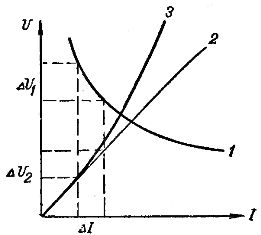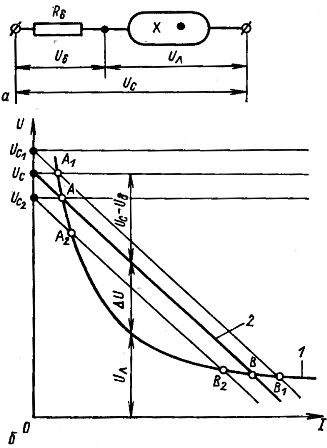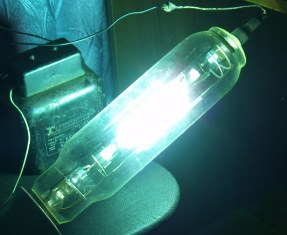Current-voltage characteristics of electric lamps
 The properties of an electric lamp as an element of an electric circuit can be fully represented by its current-voltage characteristic, that is, by the dependence of the voltage drop on it on the value of the current flowing.
The properties of an electric lamp as an element of an electric circuit can be fully represented by its current-voltage characteristic, that is, by the dependence of the voltage drop on it on the value of the current flowing.
Current-voltage characteristic of gas discharge lamps
The operation of gas-discharge radiation sources is based on an electric discharge in an atmosphere of inert gas (most often argon) and mercury vapor. The radiation occurs due to the transition of electrons of the mercury atoms from an orbit of high energy content to an orbit of lower energy. Of all the variety of electrical discharges (silent, glowing, etc.), artificial sources are characterized by an arc discharge, which is characterized by a high current density in the discharge channel. The characteristics of the arc discharge as an element of the electric circuit determine and characteristics of the schemes for the inclusion of gas discharge sources.
The current-voltage characteristic of the arc discharge is shown in Fig. 1 (curve 1).It also shows the current-voltage characteristic of the constant resistance (curve 2). For a constant resistance, the ratio is the same at every point on the characteristic. It determines in small steps the magnitude and sign of the dynamic resistance and the linearity of the characteristic.
For arc discharge characteristics, this ratio is, first, numerically variable for different points, and second, negative in sign. The first characteristic determines the non-linearity of the characteristic, and the second - the so-called "falling" character of the curve. Thus, the arc discharge has a non-linear falling current-voltage characteristic.
If you calculate the static arc resistance at several points on the curve (R = U / I), it can be seen that as the current increases, the arc resistance decreases.

Rice. 1. Current-voltage characteristics of an arc discharge (1), constant resistance (2) and an incandescent lamp (3)
When the arc discharge is directly connected to a DC network, the discharge is unstable and is accompanied by an infinite increase in current. Therefore, in this case, it is necessary to take measures to stabilize the discharge. Stabilization can be provided either by using a voltage source with a falling external characteristic (such a characteristic, for example, is specially designed for a welding generator to stabilize the welding arc), or an additional ballast resistance connected in series with a gas discharge gap. For gas-discharge radiation sources, the second method of stabilizing the discharge is used.
Let us consider the case of including a gas gap in series with an active resistance. In fig.2 shows the current-voltage characteristic (curve 1) of the gas-discharge gap and the difference between the mains voltage and the voltage drop in the ballast depending on the current (straight line 2).

Rice. 2. Scheme for turning on the gas discharge gap in series with the ballast resistance (a) and the current-voltage characteristics of the elements (b)
All steady-state modes of current flow in such a circuit must comply Kirchhoff's lawUc = Ub +Ul. This condition is met at the intersections of a straight line 2 (Uc-Ub = f (I)) with the current-volt characteristic I gas discharge gap. However, with decreasing characteristics, crossing is possible at several points, not all of which will correspond to stable mode. Stable mode will be at those points for which, as the current increases, the sum of the voltage drop across the lamp and the ballast resistance will exceeds the source voltage, i.e. Ub +Ulb +Ul
This inequality is a criterion for sustainability. The stability criterion in Fig. 2 satisfies point B. In modes to the left of point B, a positive excess voltage ΔU appears, which leads to an increase in current, and in a mode to the right of point B, a negative excess voltage ΔU appears, which leads to a decrease in current. Therefore, the regime at point B is stable or stabilized.
It should be noted that neither voltage nor current is stabilized by turning on the ballast resistance, only the arc burning mode is stabilized. In fact, when the mains voltage increases to Uc1, the combustion mode remains stable and goes to point B1 for which the current and voltage differ from the corresponding values at point B.The arc current and voltage also differ at the stable point B2 at reduced voltage Uc2.
These considerations allow us to conclude that the stability of the discharge cannot be ensured by stabilizing the voltage in the gas discharge lamp. The above DC voltage derivations and relationships are fully applicable to AC voltage circuits. To stabilize the discharge at alternating current, inductive and capacitive ballasts are used, since the losses on them are less than active ones.
Current-voltage characteristic of incandescent lamps
The current-voltage characteristic of incandescent lamps is non-linear and has an ascending character. The non-linearity is due to the dependence of the resistance of the filament on the temperature and therefore on the current: the greater the current, the greater the resistance of the filament. The increasing nature of the curve is explained by the positive value of the dynamic resistance: at each point of the curve, a positive increase in the current corresponds to a positive increase in the voltage drop. A stable mode is automatically created, that is, the current at constant voltage cannot change due to internal reasons. This allows direct connection of the filament lamp to voltage.

